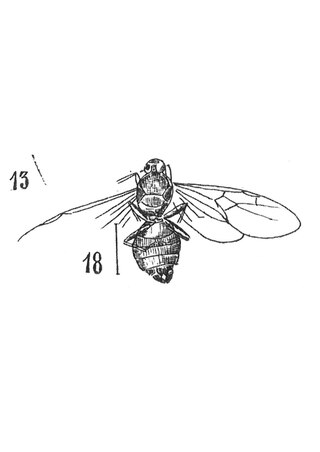
The Hepialoidea are the superfamily of "ghost moths" and "swift moths".

Bibionidae is a family of flies (Diptera) containing approximately 650–700 species worldwide. Adults are nectar feeders and emerge in numbers in spring. Because of the likelihood of adults flies being found in copula, they have earned colloquial names such as "love bugs" or "honeymoon flies".

Rana basaltica is an extinct species of frog from Middle Miocene of China. It is known from the Shanwang formation beds in the Shanwang National Geological Park, Shandong Province, China.

Corixa is a genus of aquatic bugs in the family Corixidae. The fossil species C. elegans is from the Rott Formation in Nordrhein-Westfalen.
Alloiomma is an extinct genus of ants that once belonged to the subfamily Dolichoderinae. A. changweiensis was the first extinct species to be discovered by Zhang in 1989, and another fossil species was discovered in 1994, known as A.differentialis. The ants were endemic to China.
Elaphrodites is an extinct genus of ants of the subfamily Dolichoderinae. Two fossils were discovered and described by Zhang in 1989.
Eurymyrmex is an extinct genus of ant in the Formicidae subfamily Dolichoderinae. The genus contains a single described species Eurymyrmex geologicus. It was described in 1994, where the first fossils of the ant were found in China.
Myopopone sinensis is an extinct species of ant in the genus Myopopone. Fossils were discovered in 1989 in China, and was later described by Zhang in that year.
Iridomyrmex shandongicus is an extinct species of ant in the genus Iridomyrmex. Described by Zhang in 1989, fossils were originally found in 1989, and out of all the fossils in the genus, this one has strongest support that it belongs in the genus.

Dolichoderus coquandi is an extinct species of ant in the genus Dolichoderus. Described by Théobald in 1937, the fossils were discovered in France.
Dolichoderus evolans is an extinct species of Miocene ant in the genus Dolichoderus. Described by Zhang in 1989, the fossilised species was discovered in China, where a possible queen has been described.
Dolichoderus lacinius is an extinct species of Miocene ant in the genus Dolichoderus. Described by Zhang in 1989, fossils of a queen specimen were found in China.
Dolichoderus luridivenosus is an extinct species of Miocene ant in the genus Dolichoderus. Described by Zhang, Sun and Zhang in 1994, the species was discovered after a fossil of a queen was found in China.
Dolichoderus tauricus is an extinct species of Miocene ant in the genus Dolichoderus. Described by Dlussky in 1981, the fossils were found in Russia.
Dolichoderus transversipetiolaris is an extinct species of Miocene ant in the genus Dolichoderus. Described by Zhang, Sun and Zhang in 1994, the species was discovered after a fossil of a queen was found in China.
Liometopum eremicum is an extinct species of Miocene ant in the genus Liometopum. Described by Zhang in 1989, the fossils were found in China.
Liometopum lubricum is an extinct species of Miocene ant in the genus Liometopum. Described by Zhang, Sun and Zhang 1994, the fossils were found in China.
Liometopum potamophilum is an extinct species of Miocene ant in the genus Liometopum. Described by Zhang in 1989, the fossils were found in China.
Tapinoma baculum is an extinct species of ant in the genus Tapinoma. Described by Zhang in 1989, fossils of the species were found in China.
Dolichoderus pinguis is an extinct species of formicid in the ant subfamily Dolichoderinae known from a fossil found in Asia. The species is one of a number in the genus described from fossils.




